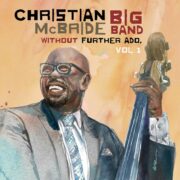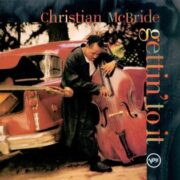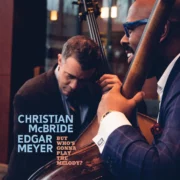It’s difficult to say whether bassist, composer and arranger Christian McBride is the most well-liked music personality, jazz or otherwise, in recent memory.
That would seem the case, however, when you consider the curatorial positions he holds (Newport Jazz Festival founder George Wein’s handpicked new artistic director, since 2017); the parties he hosts (the World at Sea Jazz Cruise); and the many collaborations for which he commands a gravitational pull — too long a list, since his start at age 17 with Bobby Watson’s ensemble, through apprenticeships with jazz elders Freddie Hubbard and George Duke, working with peers Questlove and Roy Hargrove, and having Sting’s phone number in his phone gives you an idea of his hold.
The Philadelphia-born bassist’s most recent show of good fellowship is the Christian McBride’s Big Band new album Without Further Ado, Vol. 1. (Mack Avenue). It’s a work of vivid jazz colorations, opulent self-crafted orchestrations, a wooly, self-created epic “Op. 49 – Cold Chicken Suite, 3rd Movement,” and dynamic vocal teamings.
There’s a mini-Police reunion of Sting and guitarist Andy Summers on “Murder by Numbers,” a visit from old friend Dianne Reeves on “Will You Still Love Me Tomorrow” and coy collaborations with jazz’s new jacks, José James and Samara Joy, respectively, on “Moanin’” and “Old Folks.”
JazzTimes spoke with McBride about the album release as well as plans taking shape for January’s Christian McBride World at Sea — involving a tribute to the great Ray Brown, with whom McBride shared the band SuperBass before Brown’s 2002 passing.
 The next iteration of Christian McBride’s World at Sea cruise has several of the singers on your new album: Cécile McLorin Salvant, José James, Samara Joy, as well as Angélique Kidjo. And the Christian McBride Big Band will play. What sort of muscle are you stretching by curating and hosting this cruise?
The next iteration of Christian McBride’s World at Sea cruise has several of the singers on your new album: Cécile McLorin Salvant, José James, Samara Joy, as well as Angélique Kidjo. And the Christian McBride Big Band will play. What sort of muscle are you stretching by curating and hosting this cruise?
Originally, I was on the Jazz Cruise to play, like ten years ago, and wound up as its host. The Blue Note at Sea Cruise soon developed, which was more of a combination of the Jazz Cruise and the Contemporary Jazz Cruise. The Blue Note Cruise eventually went away, and Michael Nazaroff (director of Entertainment Cruise Productions, The Jazz Cruise, The Smooth Jazz Cruise and Blue Note at Sea) believed that, from a musical standpoint, a cruise geared toward straightahead jazz was necessary, but with more modern players too such as Robert Glasper, Kamasi Washington, Terrace Martin. He thought that should be my cruise, that blend.
The muscle this cruise works in terms of curating, hosting and playing — that’s not new. It certainly keeps me busy. And having done some of these outside projects for so long, multiple muscles are getting stretched. Rarely do I get an opportunity to just show up and play like I used to. Now it’s all inclusive of many things.
I’ve always paid close attention to what the audience is reacting to, keeping mental notes on what people are into, in what different region. There’s a real science to that. It’s important to find out what you love as an artist and stick with that, but, every now and then, it’s good to see what the people are reacting to and tweak it. That’s been a great science project for me.
Coming of age in the ’90s in Philly, before you became a leader, did you have an idea of the science project, the diverse curatorial roles becoming your life at some point?
Not at all. If I could go back to the mid-’90s when my first CD was released, all I figured was that eventually I’d spend more and more time being a bandleader. Period. I wasn’t thinking about anything curatorial, educational, broadcasting — none of that. I assumed I would be playing gigs, and maybe, like Art Blakey or Betty Carter, do something that would bring up the next generation. Which I like to think I’m doing a little bit of now, but in the midst of a whole lot of other things.
Do you recall the moment where you thought that perhaps you should be more than a bass player or leader?
I just got thrown into situations where I had to do that. It probably started with education. Not too long after Gettin’ To It was released, Berklee’s Rich Appleman asked me to curate a series of master classes there — whatever I wanted, as long as I did four of them. I don’t even remember what I came up with.
I do recall that I was very nervous about it. It was 1997. I was 25. I think there was some part of me that was paranoid that the students in that classroom weren’t much younger than me. I felt under-equipped. In fact, to underline my naïveté, to make myself look older, I went down the street before the first class, and bought myself a cigar, stood in front of the main building at Berklee and smoked it. I thought I could con myself into feeling older than I was.
Still, word got around, and I got more offers to do more workshops, lectures and master classes, which led to my first artistic directorship at the University of Richmond, then Jazz Aspen, then the Brubeck Institute. All of a sudden, I’m in this artistic directorship seat. Where in the world did this come from?
Then in 2004 I met Melissa [Walker, his wife], who had just started this new organization, Jazz House Kids. While I was enjoying all this, part of me kept thinking, “Wait, I’m just a bass player.” Then Marian McPartland, who often had me as a guest on her radio show Piano Jazz, her health became fragile, and during her last season she asked me to be her substitute host.
Not long after that, WNYC asked me to sub for John Schaffer for Soundcheck. Now, I have this radio career — and again, I had to ask what happened to my bass gig. It was all so organic and so fast, one thing after the other. It was a journey, but one where I always paid attention to the people, what they want, what they need. And here we are.
Do you feel as if curating the Newport Jazz Festival answers that question as to where the bass is? This year you managed to play there with three different Christian McBride ensembles — is that reminding you that you are an artist first?
No, Newport is really a combination of everything we just discussed. First and foremost, it’s about curation. The playing part is probably the last thing on the list. Walking that tightrope is never simple: keeping a foot in the tradition — and you’re always toying with that tradition — while keeping your finger on the pulse of what is contemporary. That can be fun, and not fun, on occasion.
Do you remember what George Wein said to you when he asked you?
He told me he’d been keeping an eye on me and things I had been doing. Most specifically, the 2006 to 2010 creative chair for jazz role that I held for the Los Angeles Philharmonic, which involved 12 shows per season at the Hollywood Bowl and the Walt Disney Concert Hall. George told me he was impressed by the things I had done away from the bass, that I had an eye on the larger community. I was surprised by all that, especially since George and I weren’t that close. But he was just in tune.
 You mentioned your first album, so I’ll jump in with it being 35 years since your first sideman gig on a record, for fellow Philadelphian Wallace Roney and his Obsession album. It’s also 30 years since your back-to-back start as a leader with Gettin’ to It and Number Two Express. What sticks out most about that fast five-year swing?
You mentioned your first album, so I’ll jump in with it being 35 years since your first sideman gig on a record, for fellow Philadelphian Wallace Roney and his Obsession album. It’s also 30 years since your back-to-back start as a leader with Gettin’ to It and Number Two Express. What sticks out most about that fast five-year swing?
I can’t speak for everyone, but the early-to-mid-’90s were extremely exciting. So many of my musical heroes were still alive and within reach. To think that you could go to Sweet Basil and talk to McCoy Tyner and get a gig with Freddie Hubbard at 18, befriend Benny Green, and watch Roy Hargrove’s ascension, being a part of that. Even down to watching Wynton doing his Lincoln Center thing and Branford taking over The Tonight Show band, then turning around and saying how that network television thing wasn’t for him [laughs] … there was so much going on.
And about your actual playing — by the time we get to this new album and your life as a leader and an orchestrator, where is your playing now, would you say?
For better or worse, right or wrong, I don’t really consciously think about my playing much. Maybe I would play better if I kept a closer eye on it, without these other agendas. There’s a part of me that says that it is much more meaningful to me, at the moment, that what I produce as a musician, doesn’t mean as much to be centered around the bass.
People in the jazz world know, by this point, how I play. I don’t need any bass solos or features. I don’t need to rewrite a new bass language. That’s why, with this album … I just saw a review, it was a nice review. But they were surprised that there were few [bass] solos on this recording. And I thought, “Yeah, exactly.”
Other than to showcase your arranging, your orchestration, your taste and your curation of vocal talent, what do you get most out of Without Further Ado?
Possibly having a lot of musicians thinking that, from a musical standpoint, that they can trust me.
What’s the biggest difference, then, between having a big band of musicians trust you and a trio or quartet?
Trust is trust, big group or small. I don’t have any agenda here, other than making sure that everyone feels good within my vision. My concept. I have the direction where I want to go, but I don’t want musicians feeling that they are handcuffed. That they are only to thrive under my rules. That direction. Especially with singers.
 My goal is to say “What do you want?” and then I will make it work for you. No matter what a vocalist or soloist tells me, I am there for them. I already have my voice. I know my individualism. I am comfortable making sure that people have what they need. I’m not worried about me. I’m gonna get mine, don’t worry about that.
My goal is to say “What do you want?” and then I will make it work for you. No matter what a vocalist or soloist tells me, I am there for them. I already have my voice. I know my individualism. I am comfortable making sure that people have what they need. I’m not worried about me. I’m gonna get mine, don’t worry about that.
Where did you first truly develop that big band sound of yours?
Dizzy’s. Starting in 2012, I had an annual residency there, my big band played a week there every April. That’s when I really got to sink my teeth in and get the band nice and tight. Sadly, Covid changed all of that. We did one last run there in 2022 but the damage had been done. So many financial organizations took a hit during the pandemic — you can’t pay a big band in those conditions. Hopefully we can get an opportunity such as Dizzy’s again.
How did the selection process start when it came to vocalists?
It was much more pragmatic than that. I began looking at this pile of music and arrangements that I had compiled over the last decade, thinking I should get these recorded. Originally this was going to be a much bigger project, just put the whole thing out at once. But Mack Avenue decided to make it two separate releases — hint, hint. The only [arrangements] written specifically for this first volume were “Murder By Numbers” and “Old Folks.”
With “Murder by Numbers” you pretty much have a Police reunion on your hands. How did it happen to be two guys without the third?
It was never meant to be some sort of Police thing. Getting Andy was Sting’s idea. We had considered doing Sting’s “Shadows in the Rain,” and told him that, [but then] I heard “Murder by Numbers” on the radio. He said if we really wanted to do “Murder,” that he could probably get Andy. Sting offered that. I was completely shocked.
The next thing you know, 20 minutes later, I’m on an email thread with Andy Summers. It was unbelievable. For various reasons, I wasn’t going to ask Stewart Copeland because any sort of actual Police reunion probably would have been a legal nightmare. Sting did it because we’re friends and we have that relationship. Andy didn’t have to do this.
Hooking up with Samara Joy for the new album — so much of vocal jazz’s future is pinned to her. What does her talent, that voice, signal to you?
What I love about Samara is that she has made it very clear that she loves singing jazz. That her heart is devoted to jazz. You don’t hear that from a lot of [people in their 20s], particularly in this era. People normally use jazz to get their foot in the door, get momentum, then leap to something bigger like R&B or pop, or a contemporary hybrid where the jazz eventually disappears. They don’t want to get called out as a jazz singer, as if that is a problem.
Samara, though, says it all the time, on and off the record, how much she loves singing this music. I think that is a powerful thing to hear, especially for her contemporaries and younger potential jazz vocalists coming up behind her. She’s an oddly incredible talent [who] has this familiar, comforting, old-school sound. I can remember being one of the judges at the 2019 International Sarah Vaughan Vocal Competition, which Samara won. Dee Dee Bridgewater was also one of the judges. When Samara came out and sang, we all did a “who-in-the-world-is-this” thing. We all know the rest of the story. And she knows how to still be a 20-something while maintaining this old-soul vocal sound.
Do you want to say something about the origins of “The Cold Chicken Suite”?
This is the universal problem for all traveling musicians, I don’t care what genre. Whatever you play, if you get hungry after two o’clock in the morning, there is nothing left but cold chicken. Now, this is an over-40-year-old’s problem. If you’re younger than that, your options are still wide open. JT
